Introduction
Definition of body condition score. The body condition scoring (BCS) is a subjective measure of the energy reserve and indirect indicator of the energy balance in a dairy cow. It is non-invasive, quick and inexpensive method to estimate degree of fatness. It is a means of accurately determining body condition of dairy cows, independent of body weight and frame size. The amount of BCS a cow is losing is associated with the milk production reproduction and health. Cows with low body condition is associated with risk of lower milk yield and higher somatic cell count (Berry et al., 2007).
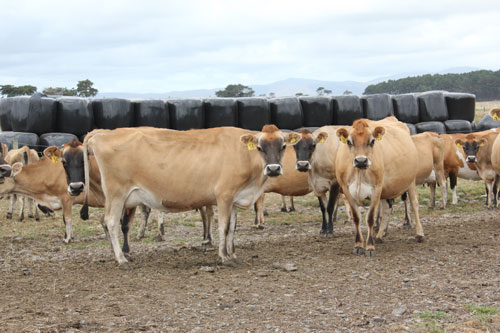
Condition scores can be used on both heifers and cows, although primarily the are used on the lactating dairy herd. Although many may consider this as a nutritional management practice, but changing BCS have implications on milk yield, health, reproduction, longevity and overall profitability of an animal. A fat cow is more susceptible to metabolic problems and infections, and is more likely to have difficulty at and after calving. Under conditioning, or thinness, can frequently lower production and milkfat levels because of insufficient energy and protein reserves to maintain production. Thin cows often do not show heat or conceive until they start to regain–or at least maintain–body weight. Cows should be scored both by looking at and handling the backbone, loin and rump areas. Body condition scoring in dairy cattle is a visual and tactile evaluation of body fat reserves using a 5-point scale with 0.25-point increments. Body condition scores (BCS) are an indirect estimate of energy balance. A score of 1 denotes a very thin cow, while 5 denote an excessively fat cow, and 3 is an average body condition.
- BCS as a mirror of image of milk lactation profile BCS score of 2.75-3.0 at calving has been suggested to minimize BCS losses (Roche, 2006)
- BCS variation with the lactation cycle BCS level at calving and the milk yield are responsible for the amount of decline in the BCS post-partum.
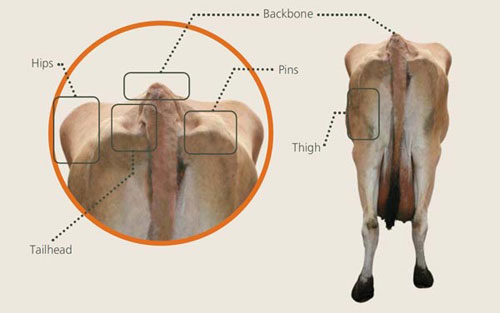
BCS have a strong correlation with the condition of claw horn of cow, so those cows which have a horn disruption have less chance to conceive as compared to those cows without horn disruption. Cows with more BCS at calving have more tendency to develop metabolic disease after parturition. While those cows which have low BCS at calving have large inter calving interval and have increase in number of insemination to conceive.
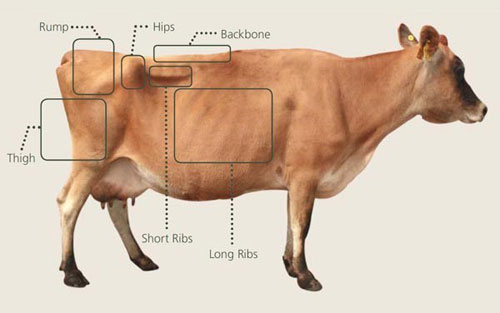
Objective of this study
The objective of this study is to determine the relationship between BCS and the milk yield of Jersey cross-bred dairy cows.
Review of Literature
Rocheet al., (2013) suggested that over-conditioned cows (BCS≥4.0) were not productive and had higher risks for metabolic problems
Rocheet al,. (2013) found that periparturient climatic, animal, and management factors influencing the incidence of milk fever in grazing systems
Bayram et al.,(2012) found the effect of body condition score (BCS) at calving and during the first month of lactation on some reproduction and milk yield traits of Swedish Red and White (SRW) cows organically raised in Turkey. The BCS at calving did not have an effect on the lactation length, peak daily milk yield and days to attain peak milk yield. The condition score obtained in the first month of lactation only affected the peak daily milk yield.
Machadoet al., (2010) conduct a study to evaluate the effects of claw horn disruption lesions (CHDL; sole ulcers and white line disease) and body condition score (BCS) at dry-off on survivability, milk production, and reproductive performance during the subsequent lactation. And found that cows without CHDL were 1.4 times more likely to conceive than cows with CHDL.
Ataseveret al.,(2009) Association between subclinical mastitis markers and body condition scores of Holstein cows in the Black Sea region, Turkey .Here the Somatic Cell Count and Electrical Conductivity of milk levels were used as Subclinical Mastitis Marker .In this study there was no correlation between SMM and BCS.
Berry et al., (2007) noticed that the greater the increase in BCS at calving the lower the SCS in primiparous rather than multiparous dairy cows.
Rocheet al., (2006) reported that the interaction between BCS at calving and at parity was consistent with a lack of milk fever in primiparous cows. In this study, the feed (concentrate) have direct role in reduction in post-partum interval. Concentrate supplementation tended to accelerate the rate of incline to peak milk yield, but persistency of lactation was not affected.
Gillundet al., (2001) found that body condition is directly related to ketosis and reproductive performance in Norwegian dairy cows. Animal with high BCS at calving have more chances of ketosis. Summer calving cows and primiparous cows showed lowest risk of ketosis. While those cows which shows loss in body condition at postpartum will lead to increase Inter calving period, increase number of Insemination.
Flamenbaum et al.,(1995) suggested that the impact of BCS on subsequent health condition, Cow with low BCS suppressed peak milk yield and milk production traits in dairy herds, but cows with high BCS had no advantage in milk production. Cows with improved body condition during spring will have improve milk yield in summer and have high feed intake.
Materials and Method
The experiment was conducted in the LFC, Dairy farm, CSKHPKV, Palampur on the Jersey cross bred cows. Fifty cows were included in the study. The body condition of the cross-bred cows were assessed using 1-5 scale (Edmonson et al.,) The eight areas of the cow’s body were examined and criteria within each area were used to indicate the body condition.
The eight locations (B1 to B8) examined were in three major regions:
-
Loin
B1 spinous processes, (the vertical prominances of the lumbar vertebrae)
B2 depression between the spinous and transverse processes
B3 transverse processes (the transverse prominances of the lumbar vertebrae)
B4 overhanging shelf formed by the transverse processes above the flank.
-
Pelvis
B5 tuber coxae (hooks) and tuber ischii (pin bones) bony prominences
B6 depression between the hook and pin bones
B7 depression between the hooks.
-
Tail head
B8 spinous and transverse processes of the coccygeal vertebrae and isciorectal fossa (depression beneath the tail). Further, the lactation yield, lactation length, peak yield and service period is also records of the dairy farm. Data were analysed to see the effect of Body condition score in different lactation period on the milk yield of the cross bred cow.
Data Collected
|
Tag No. |
Milk Yield | Parity No. |
BCS |
| 2141 | 1.5-2 | 11 | 2.5 |
| 2142 | 1-1.5 | 10 | 2.5 |
| 2174 | 3-3.5 | 5 | 275 |
| 2178 | 1-1.5 | 5 | 2.75 |
| 2201 | 1.5-2 | 7 | 2.5 |
| 2207 | 3-3.5 | 5 | 2.5 |
| 2239 | 4-4.5 | 4 | 2.5 |
| 2249 | 2-2.5 | 2 | 2.5 |
| 2254 | 2-2.5 | 2 | 2.75 |
| 2261 | 3.5-4 | 1 | 2.75 |
| 2223 | 2-2.5 | 4 | 2.5 |
| 4194 | 1.5-2 | 10 | 2.5 |
| 4224 | 2-2.5 | 7 | 2.5 |
| 4240 | 1.5-2 | 9 | 2.5 |
| 4266 | 2-2.5 | 6 | 2.5 |
| 4275 | 2.5-3 | 6 | 2.75 |
| 4280 | 2-2.5 | 7 | 2.5 |
| 4287 | 4-4.5 | 9 | 3.25 |
| 4317 | 1-1.5 | 5 | 2.5 |
| 4325 | 4-4.5 | 6 | 2.5 |
| 4327 | 3-3.5 | 6 | 3.0 |
| 4335 | 2-2.5 | 4 | 2.5 |
| 4341 | 3.5-4 | 6 | 2.75 |
| 4354 | 4-4.5 | 5 | 2.75 |
| 4448 | 3.5-4 | 2 | 2.75 |
| 4461 | 6-6.5 | 4 | 2.75 |
| 4469 | 6-6.5 | 2 | 2.5 |
| 4476 | 4-4.5 | 2 | 2.75 |
| 4503 | 3-3.5 | 2 | 2.75 |
| 4379 | 2.5-3 | 4 | 2.75 |
| 4477 | 4-4.5 | 2 | 2.5 |
| 4478 | 6-6.5 | 2 | 2.5 |
| 4479 | 2-2.5 | 1 | 2.75 |
| 4480 | 2.5-3 | 1 | 2.5 |
| 4481 | 2-2.5 | 1 | 2.5 |
| 4485 | 2.5-3 | 2 | 2.75 |
| 4487 | 2-2.5 | 1 | 2.5 |
| 4488 | 2-2.5 | 1 | 2.75 |
| 4489 | 3-3.5 | 2 | 2.5 |
| 4494 | 2.5-3 | 1 | 2.75 |
| 4495 | 2-2.5 | 1 | 3 |
| 4500 | 1.5-2 | 1 | 2.5 |
| 4506 | 1.5-2 | 1 | 2.75 |
| 4516 | 2-2.5 | 1 | 2.5 |
| 4518 | 2-2.5 | 1 | 2.5 |
| 4431 | 1.5-2 | 2 | 2.5 |
| 4422 | 4.5-5 | 4 | 3 |
| 4434 | 2.5-3 | 3 | 2.75 |
| 4435 | 2.5-3 | 4 | 2.75 |
| 4440 | 5.5-7 | 3 | 3 |
Table 1. Relationship between cows and milk yield in early lactation
|
BCS score |
≤2.5 | 2.75 |
≥3 |
| No. of Cows | 5 | 5 | 3 |
| Proportion of cows | 0.384 | 0.384 | 0.23 |
| Average milk yield | 7.7 | 7.6 | 7.5 |
Table 2. Relationship between cows and milk yield in mid lactation
|
BCS score |
≤2.5 | 2.75 |
≥3 |
| No. of Cows | 4 | 4 | 2 |
| Proportion of cows | 0.4 | 0.4 | 0.2 |
| Average milk yield | 6.25 | 6 | 9.75 |
Table 3. Relationship between cows and milk yield in late lactation
|
BCS score |
≤2.5 | 2.75 |
≥3 |
| No. of Cows | 17 | 10 | 0 |
| Proportion of cows | 0.629 | 0.37 | 0 |
| Average milk yield | 4.1 | 5.5 |
Table 4. Relationship between cows and milk yield in overall
|
BCS score |
≤2.5 | 2.75 |
≥3 |
| No. of Cows | 26 | 19 | 5 |
| Proportion of cows | 0.52 | 0.38 | 0.1 |
| Average milk yield | 5.13 | 6.15 | 8.4 |
Table 5. Relationship of BCS with High and Low yielders
| Particular |
Early lactation |
Mid lactation |
Late lactation |
|||
|
Low |
High yielders |
Low Yielders |
High yielders |
Low Yielders |
High |
|
| Milk Yield (in Litres) |
< 7.6 | >7.6 | <6.8 | >6.8 | <4.6 | >4.6 |
| BCS | 2.67 | 2.75 | 2.67 | 2.75 | 2.57 | 2.72 |
Conclusion
Dairy cows in the early lactation having BCS score of ≤2.5) had a higher milk yield when compared to the cows having higher BCS score (2.75 and ≥3.0). This may be due to higher rate of mobilization of body reserves in the high yielding cows. Also the high yielding cows tend to lose more body weight during early lactation. The BCS and the milk yield of the dairy cows in both the groups (High and Low yielding) decreased in mid and late lactation. However, in the late lactation high yielding cows had better BCS when compared to the low yielding cows, which may be due to positive energy balance. Therefore, it is concluded that we should target higher BCS at time of calving for getting more milk yield in early lactation and replenish the body reserves lost during lactation by manipulating the energy intakes of the dairy animal in late lactation.
Reference
- Atasever, S., &Erdem, H. (2009). Association between subclinical mastitis markers and body condition scores of Holstein cows in the Black Sea region, Turkey. J. Anim. Vet. Adv, 8(3), 476-480.
- Bayram, B., Aksakal, V., &Akbulut, O. (2012). Effect of the body condition score on some reproduction and milk yield traits of Swedish red and white cows. J Anim Plant Sci, 22(3), 545-551.
- Berry, D. P., Lee, J. M., Macdonald, K. A., & Roche, J. R. (2007). Body condition score and body weight effects on dystocia and stillbirths and consequent effects on postcalving performance. Journal of Dairy Science, 90(9), 4201-4211.
- Flamenbaum, I., Wolfenson, D., Kunz, P. L., Maman, M., & Berman, A. (1995). Interactions between body condition at calving and cooling of dairy cows during lactation in summer. Journal of dairy science, 78(10), 2221-2229.
- Gillund, P., Reksen, O., Gröhn, Y. T., & Karlberg, K. (2001). Body condition related to ketosis and reproductive performance in Norwegian dairy cows. Journal of dairy science, 84(6), 1390-1396.
- Machado, V. S., Caixeta, L. S., McArt, J. A. A., &Bicalho, R. C. (2010). The effect of claw horn disruption lesions and body condition score at dry-off on survivability, reproductive performance, and milk production in the subsequent lactation. Journal of dairy science, 93(9), 4071-4078.
- Roche, J. R., Berry, D. P., &Kolver, E. S. (2006). Holstein-Friesian strain and feed effects on milk production, body weight, and body condition score profiles in grazing dairy cows. Journal of dairy science, 89(9), 3532-3543.
- Roche, J. R., Kay, J. K., Friggens, N. C., Loor, J. J., & Berry, D. P. (2013). Assessing and managing body condition score for the prevention of metabolic disease in dairy cows. Veterinary Clinics: Food Animal Practice, 29(2), 323-336.
- Roche, J. R., Kay, J. K., Friggens, N. C., Loor, J. J., & Berry, D. P. (2013). Assessing and managing body condition score for the prevention of metabolic disease in dairy cows. Veterinary Clinics: Food Animal Practice, 29(2), 323-336.



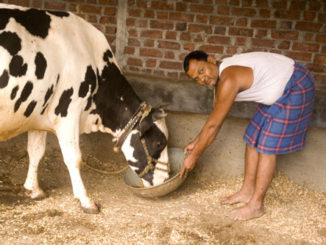
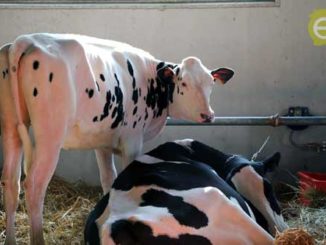

Be the first to comment